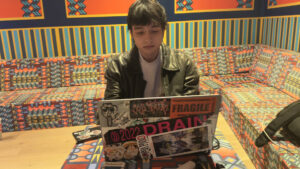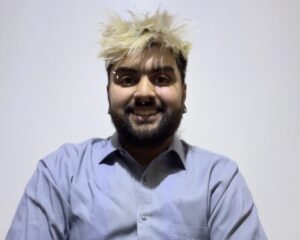
Cezar Regala, age 21, tries to figure out how to incorporate discarded nicotine products into his project. (Photo by Naim Ali-Pacheco.)
This story was produced in collaboration with CivicStory as part of the Ecology-Civics Reporting Project.
In Newark, New Jersey’s largest city, a group of Rutgers-Newark graphic design students is using local waste—such as river water, discarded vapes, and bioplastics—to create art that engages with environmental themes. The group, called Type Sh(), was founded by eight Rutgers graphic design students.
As graphic designers focused on different mediums it’s hard to find all the members in one place at the same time. They can be seen roaming around different parts of the Rutgers Newark campus. Some are hunched computers over examining miniscule details in the printing lab of 110 Warren Hall while others are finding quiet and empty rooms to channel their creative flow in Express Newark. Very rarely do they see each other all at once except when they all get together for a beer at McGovern’s Tavern, but the group is connected through their passion for their work and the communities they want to help.
“Type Sh() is a little project some fellow junior graphic designers are working on,” said one of the group’s founding members, Cezar Regala. “Just a little type foundry and design firm that we want to start up.”
The group stylizes their name as Type Sh(), with empty parentheses meant to represent “a nonfactor,” Regala explained—“something that could be replaced with anything, really.” The name reflects their goal of creating work that is diverse and individualistic, rooted in design but driven by broader issues. The student-led collective combines design, science, and community awareness in a series of projects that explore the relationship between people and the ecosystems they inhabit.
Newark was recently ranked one of the dirtiest cities in the country—fourth nationwide and first in New Jersey—according to LawnStarter’s 2024 report. The city’s environmental struggles are especially visible in the Ironbound neighborhood, which ranked in the 92nd percentile nationally for diesel particulate matter exposure and in the 96th percentile for respiratory hazard index in 2023, according to the Center for New York City Affairs.
In response to these ongoing issues, Regala and his fellow design students decided to use Newark’s environmental challenges not just as inspiration, but as materials for their creative work.
Currently, members of the collective are working on cross-disciplinary projects that merge graphic design with environmental science—or, as Regala puts it, “SCI art and bio art.” His own contribution includes using polluted water from the Passaic River, along with print-based elements and microscopic photography. “I don’t want to get too in-depth into it,” he said, “but yeah, it’s going to involve some microscopic photography and video, some print-based aspects, as well as some 3D and projector-based elements.”
Regala credits his inspiration to Andrea Haenggi, the current artist-in-residence at Rutgers’ Paul
Robeson Galleries. Her piece, MARISMAS DE MAREAS OLVIDADAS (FORGOTTEN
TIDAL MUDFLATS), explores the mudflats in the lower Passaic River, specifically in Newark. Building on Haenggi’s work, Regala and his peers see their practice as part of a larger movement to reimagine how we engage with polluted environments—not as spaces to avoid, but as places to confront, study, and care for.

Regala inside Subtle Center at Express Newark’s Box Gallery. (Photo by Naim Ali-Pacheco.)
The group is also engaging with environmental waste in more literal ways. “I’m currently collecting used and discarded nicotine products,” Regala said, referring to a sculpture he’s building from vape pens and cigarette butts. While the piece primarily comments on addiction, it also addresses environmental impact. “Everywhere you go, you walk around, you’ll find dead vapes on the ground… people don’t really consider it littering. They just, you know, throw it.” Other members of the group are taking similarly unconventional approaches. For Miranda Peña, a junior majoring in graphic design and a tattoo artist, the material itself is a crucial collaborator. “I wanted to use bioplastic or some sort of repurposed leather from a thrift store,” she said. “I want to use stuff that can be recycled or repurposed so I’m not wasting material and helping clean up Newark a bit.” The unpredictability of the material adds to the project’s organic nature, she explained. “It’s kind of like working with another body. You don’t control everything—it has its own timeline.”
Another medium students are working with are apps and websites. Peña is also designing a transit-focused app that reflects her interest in sustainability and urban accessibility. The app functions as an archive of the most walkable areas accessible by public transit from the RutgersNewark campus. “It’s to kind of enable people to get away from car-centric infrastructure,” she explained, adding that it’s not just about environmental impact, but also about supporting community. “That makes a better functioning city,” she said.
Transportation is a significant contributor to New Jersey’s environmental challenges, especially in urban areas. Personal vehicles are responsible for nearly 40% of the state’s carbon dioxide (CO₂) emissions, according to the New Jersey Department of Environmental Protection (NJDEP). Nitrogen dioxide (NO₂) and carbon monoxide (CO) emissions from vehicles are also major pollutants contributing to smog and respiratory illness, especially in densely populated areas like Newark. The Environmental Justice History Project also reports that Ironbound recorded some of the highest air toxics respiratory hazard levels in the country, posing serious health risks for residents. By focusing on projects that encourage sustainable alternatives to car use, such as Peña’s transit app, Type Sh() hopes to raise awareness about these pressing issues.
Their long-term goal, Regala said, is to stay local and contribute to the Newark community. “We want to focus on the community of Newark itself,” he said. “We want to work really locally and try to give back to this community… especially Newark, Rutgers-Newark—we’d love to work with them in the future.”
This story was produced in collaboration with CivicStory as part of the Ecology-Civics Reporting Project.
Co-published with The Observer.

